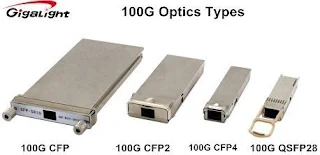As the network is gradually upgraded from 25G-40G-100G, people have more demands on the 100G optical transceiver to deploy data centers or Ethernet. Maybe most people are familiar with 100G optical transceiver module on account that it is widely applied in daily life. However, if we know it from these other perspectives, something new will be found. Then there is an introduction to it in this article from Gigalight. Let’s have a look at it together.
The Development Process of 100G Optical Module
The earliest-generation 100G optical module is CFP developed in 2010. Then IEEE published other three standards of the 100G optical module: 100G SR10, 100G LR4, and 100G ER4, respectively supporting 100m, 10Km, and 40Km transmission. After that, the 100G SR4 project was put forward to be added to the IEEE standard, but it was not implemented on account that it was not reached a consensus in 2013. Till 2016, most of the 100G optical modules used in various data centers adopted 25Gbps Serdes program. Gradually, the 100G optical module adopting the 50Gbps Serdes program was developed.
Types and Advantages of 100G Optical Module
The form factors of 100G optical transceiver mainly include CFP/CFP2/CFP4, 100G QSFP28. For their comparison in advantages, the main factors to be considered are the cost and power consumption of data centers.
The following is the respective introduction to advantages of 100G optical transceivers.
1. CFP optical transceiver supports full C-band wavelengths tunable and can complete the link detection. It uses a common optical dual-binary modulation ODB, convenient for setting, power consumption less than 24W.
2. The volume of CFP2 optical transceiver is half of CFP. Its integration level is 2 times that of CFP. It can complete stable receiving sensitivity in the range of wide dynamic input based on SOA, fully supporting a CFP optical transceiver. In addition, its power consumption is lower than 9W.
3. The volume of CFP4 optical transceiver is half of CFP2. Its integration level is twice that of CFP2, the port density of the front panel is also the double of CFP2. CFP4 optical transceiver is conformed to the MSA protocol, supporting the same rate as CFP/CFP2. Its transmission power increases significantly, but the power consumption drops significantly, only about half of the original. Besides, the system cost is lower than that of CFP2. Simultaneously, CFP4 optical transceiver completes 100G transmission via 4 * 25G channel, with higher transmission power and higher stability.
4. The form factor of QSFP28 optical transceiver is smaller than that of CFP4 optical transceiver. The power consumption of QSFP28 optical transceiver usually does not exceed 3.5W. The adoption of QSFP28 optical transceiver can make it achievable to upgrade the network from 25G to 100G not through 40G so that the cost is lower.
Challenges That 100G Optical Module Faces
1). Nonlinear Effects: compared with the nonlinear effects of the 10G/40G optical transceiver, that of the 100G optical transceiver is more chaotic.
2). PMD Tolerance: under the same conditions, the PMD (Polarization Mode Dispersion) tolerance of 100G optical transceiver module is 1/10 of the 10G optical transceiver module, accounting for 4/10 of the 40G optical transceiver module. Therefore, the coherent reception plus digital signal processing should be chosen for the application.
3). CD Margin: under the same conditions, the dispersion tolerance of 100G optical transceiver only needs 1/100 of the 10G optical transceiver, accounting for 16/100 of the 40G optical transceiver. Therefore, 100G optical transceivers can use dispersion compensation technology to complete the dispersion compensation for each wavelength in the electric field or the optical domain.
4). Channel Distance: the DWDM system that supports the range with 50GHz wavelength has been popularized. 100G optical module needs to satisfy the condition that it supports the distance of the 50GHz wavelength, so the code pattern of the high-spectrum power should be used.
5). OSNR (Optical Signal to Noise Ratio): when the code type is same, the 100G optical module is required to increase 10dB higher than 10G optical module, and 4dB higher than the 40G optical module. Therefore, the code type with a low OSNR tolerance and an FEC algorithm with high coding efficiency are needed.
Conclusion
It is believed that the answer is clear in your mind. Seen from the above viewpoints, in the development process of the 100G optical transceiver module, although much 100G optics with different form factors emerge to bring effective solutions for 100G Ethernet or data centers, by virtue of their advantages in many aspects, and 100G optics actually faces various challenges.


Post a Comment